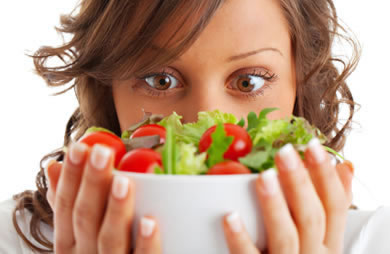How to EatDo you sometimes feel like you're being bombarded with hot-off-the-presses information about the best way to eat? (Gluten-free will help you lose weight! Swap sugar for agave! Fat-free is healthiest!) It's enough to make you think the heck with it and grab a bag of cookies. Deep breath: It's not nearly as complicated or restrictive as it seems. Ditch these old misconceptions and follow this simple advice.You’ve heard: Eat nine servings of fruits and vegetables a day.New thinking: Fill half your plate with produce at every meal.Of course it's ideal to eat your nine servings, but who can keep track? This new guideline, from both the Harvard School of Public Health and the USDA, is an easier, don't-have-to-think-about-it way to make sure you're eating enough of the good stuff. "Nothing is more important to lowering your risk of just about every ailment—especially cancer and heart disease—and staying at a healthy weight (or losing it if you need to) than eating lots of produce," says registered dietitian Elizabeth Somer, MA, RD, author of Eat Your Way to Sexy. As for the other half of your plate? One-quarter should be lean protein (fish, chicken, lean cuts of pork and beef) and one-quarter whole grains (brown rice, whole-wheat pasta, couscous). You’ve heard: You can lose weight by going gluten-free.New thinking: Don’t restrict gluten; simply eat more fresh foods.Gluten (a protein found in wheat) has nothing to do with weight gain, and simply switching from regular bread, pasta, rice, crackers and cookies to gluten-free products may actually cause you to add pounds. "The gluten-free varieties are often higher in sugar, fat and calories than regular versions," says Rachel Begun, MS, RD, and spokesperson for the Academy of Nutrition and Dietetics. If you're wondering why that friend who gave up gluten looks slimmer, it's probably because she cut back on high-calorie packaged foods like muffins, cakes and crackers—that's a smart move for anyone. If you do likewise, and replace these products with unprocessed, naturally gluten-free foods like fruits, vegetables, meats, lowfat dairy, nuts and beans, you will lose weight, too. "But that's because you're eating an overall healthier diet, not because you eliminated gluten," says Begun. The only people who need to avoid gluten are those who experience symptoms when they eat it. See your doctor if you have bloating or abdominal pain (especially after eating) and suspect you have Celiac disease—a chronic, often debilitating condition in which gluten damages the lining of the small intestine so it doesn't absorb crucial nutrients from food. No matter what, if you decide to go gluten-free, visit your doctor first. You’ve heard: Butter substitutes are always better.New thinking: Use small amounts of real fats, like butter or oil.A swipe of butter alternative instead of the real deal on your morning toast to help cut back on calories and saturated fat is fine, but don't replace butter with substitutes across the board when baking or cooking. "A lot of my patients think the substitutes don't count, so they end up using a lot and eating more fat and calories than if they just went with the real thing," says Karen Klimczak, LDN, RD, at Mindful Nutrition Counseling in Chicago. Plus, the substitutes usually aren't much lower in calories and don't enhance the taste of your food, which may make them less satisfying and cause you to eat more. "Some of these products contain artificial ingredients that don't break down in cooking and may change the taste or texture of your food," she says. To keep calories in check, simply scale back. For example, if dinner calls for several tablespoons of butter, use half and replace the rest with broth to enhance flavor. If you're baking brownies or breads, substitute half of the oil or butter required with a pumpkin purée or applesauce—the taste and texture will be just as delicious, says Klimczak. But if it's a cherished recipe you make only once a year, keep it as is and savor every bite. Often it's feeling deprived of your favorites that leads to overeating and weight gain, not a little butter here and there. Click here for more new food rules! Stories you might like: Did any of these surprise you? If so, which ones? Do you already follow some of the new food rules? Provided Photo |
More From SparkPeople |

.jpg)











.png)
